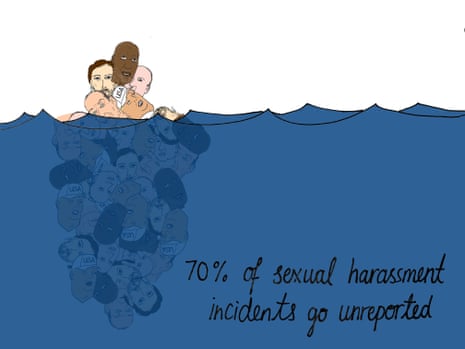Although you may have heard the name Harvey Weinstein (the Hollywood producer who denies sexual harassment accusations by roughly a dozen women) as well as Bill Cosby or Roger Ailes, there are countless names of alleged sexual harassers you haven’t heard, and will never hear. Those visible men are just the tip of the iceberg, because most cases of sexual harassment never get reported.
Only 27% of people who experience sexual harassment report it, according to a survey of 1,000 adults that was conducted by YouGov in 2013, 70% said they didn’t report it and 4% of respondents “prefer not to say” (those figures don’t add up to 100 because of rounding).
There should be better data than that, but sexual harassment isn’t studied in the same way as other social issues. We poll Americans day in, day out about whether they approve of a president they can’t change until next election, but rarely bother to ask them about experiences that crime data doesn’t capture.
The power of the men who have been publicly accused (a list which includes Donald Trump) helps to keep their victims silent. As Lauren O’Connor explained in her 2015 memo to Weinstein Company executives: “I am a 28-year-old woman trying to make a living and a career. Harvey Weinstein is a 64-year-old, world famous man and this is his company. The balance of power is me: zero, Harvey Weinstein: 10.”
Those power imbalances make anonymous surveys all the more important. We have information from the US Equal Employment Opportunity Commission (EEOC) that reveals a great deal about allegations of sexual harassment. But the numbers say nothing about the allegations that were never made.
Here are a few things that the most recent data from the EEOC does tell us:
- There were 6,758 receipts of sexual harassment allegations in the US in 2016.
- 16.6% of those charges were filed by men.
- Of the cases that were settled last year (some of which were not filed in 2016), the EEOC dismissed 54% because it had “no reasonable cause to believe that discrimination occurred”. A further 23% had a result for the claimant that was deemed positive. These “favorable” outcomes include negotiated settlements, withdrawals of claims but with benefits, successful conciliations and unsuccessful conciliations (the last category means “reasonable cause” was established but there was no conciliation). The remaining 23% of sexual harassment legal claims were simply closed for administrative reasons.
That so few cases result in a positive outcome for the claimant probably helps to keep much of this iceberg under water.
DATA
Source: YouGov/Huffington Post survey of 1,000 American adults
Year: Survey was conducted August 19-20, 2013
Source: EEOC sexual harassment charges
Year: FY 2010- FY 2016
DESIGN
Before I start illustrating a statistic like this one, I spend some time trying to understand the visual language around these issues. I did a Google image search for the phrase “sexual harassment” and found dozens of illustrations of women being touched by men on their shoulders, breasts or rears. Those depictions didn’t seem to capture the diversity of experiences of sexual harassment.
I was particularly disappointed by one illustration which showed a woman at her desk, being touched on the shoulder by a man. On her desk is a framed image which seems entirely unnecessary – it’s of another man, presumably her partner. Why does the woman’s relationship status make the sexual harassment any more wrong?
Changing tack, I searched for the word “unreported” and stumbled across an image of an iceberg. It felt like the right depiction to capture the fact that so much sexual harassment goes unseen and unsaid.
If there is a statistic you would like to see visualized, please write to me at mona.chalabi@theguardian.com
